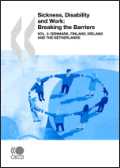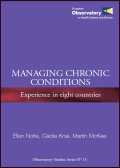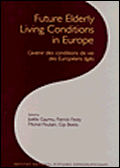SELECTED FOR YOU... FEBRUARY 2009: books of the month - working papers
All the Selected for you
BOOKS
Sickness, Disability and Work ;Breaking the barriers. Volume 3 : Denmark, Finland, Ireland and the Netherlands
Organisation for Economic Co-operation and Development . (OECD). Paris. FRA.
Paris : OECD 208 p.
Too many workers leave the labour market permanently owing to health problems, and yet too many people with reduced work capacity are denied the opportunity to work. This is a social and economic tragedy common to virtually all OECD countries, and an apparent paradox that needs explaining. Why is it that the average health status is improving, yet a persistently large number of people of working age leave the workforce to rely on long-term sickness and disability benefits?
This third report in the OECD series "Sickness, Disability and Work" explores the possible factors behind this paradox. It looks specifically at the cases of Denmark, Finland, Ireland and the Netherlands, and highlights the roles of institutions and policies. A range of reform recommendations is put forward to deal with specific challenges facing the four countries.
Experiences in the four countries offer some lessons on the importance of financial incentives for the main actors: private and public institutions (including public employment services, social insurance institutions and municipalities), employers, and workers. Good incentives will help to achieve the necessary shift in mentality, from providing insurance to activation, to promote better cooperation across actors, and to foster reform and system implementation in line with policy intentions. This should improve outcomes.
Despite a range of good-practice elements in this regard, in all four countries more can be done to avoid the flow onto benefits and to move benefit recipients back to employment. Many people with health problems or reduced work capacity can work, and want to do so. Helping those people is potentially a true "win-win" policy: it helps them avoid exclusion and have higher incomes, while raising the prospect of higher economic output in the long term.
Managing chronic conditions. Experience in eight countries
Nolte E. éd., Knai C. éd., Mckee M. éd.
Copenhague : OMS - Bureau régional de l'Europe : 2008 : 14 p. + 181 p.
Health technology assessment (HTA) aims to inform health policy and decision making processes concerning health technologies on organizational, societal and ethical issues . HTA has a strong foundation in research on the health effects and broader implications of the use of technology in health care. Its potential for contributing to safer and more effective health care is widely acknowledged in Europe and interest in this field has been growing steadily. Since the establishment of the first national HTA agency in Sweden in the 1980s, the number of institutions involved in the assessment of health technologies has multiplied in Europe. Most European Member States have established a formal HTA programme or are considering the feasibility of establishing HTA intelligence to inform health policy-making. Since its inception, the HTA community has acknowledged the need for international collaboration and networking. This book has been produced as a collaboration between the EUnetHTA Project and the European Observatory on Health Systems and Policies with the aim of reviewing the relationship between HTA and policy-making from different perspectives, with a special focus on Europe. The purpose of this cooperation is to transmit the value of HTA to a wide public in decision-making and healthcare management in order to increase their awareness of HTA activities and evidence-based decision-making.
Future elderly living conditions in Europe
Gaymu J. éd., Festy P. éd., Poulain M. éd., Beets G. éd.
Paris : Ined : 2008 : 315 p
From 2000 to 2030, the European population aged 75 and over will increase by three quarters, due to ageing of the baby-boom cohorts and improved survival up to and beyond age 75. However, it could be grossly misleading to draw too many conclusions from such simplistic indicators, and to equate the increased "weight" of the elderly population with an increased "burden". The characteristics of this population will change over the coming decades as fundamentally as their numbers, essentially because the life course of the future elderly will have differed significantly from that of their predecessors, in terms of educational attainment, family life, working career, and so on.
In FELICIE, the focus is on the health of the elderly, and on the resources at their disposal to cope with the severe impairments liable to affect their quality of life. Not only personal resources - economic well-being and educational attainment - but also the potential support of close kin, i.e. their partner, of course, and their children, if available. This leads to the more specific question of care. One major conclusion of the FELICIE study is that the disabled older adults of the future will fare better, on average, than those of today, both on a personal level, thanks to higher levels of education, and on a social level, thanks to the more frequent presence of their spouse and, at least potentially, their children.
The conclusions are based on the experience of nine countries across Europe (north: Finland, Netherlands; west: Belgium, France, Germany, United Kingdom; south: Italy, Portugal; east: Czech Republic). In terms of both demographic and social indicators, the participating countries are fairly representative of their region.
Sovereign virtue : the theory and practice of equality
Dworkin R.
Cambridge : Harvard University Press : 2000 : 511 p.
Equality is the endangered species of political ideals. Even left-of-center politicians reject equality as an ideal: government must combat poverty, they say, but need not strive that its citizens be equal in any dimension. In his new book Ronald Dworkin insists, to the contrary, that equality is the indispensable virtue of democratic sovereignty. A legitimate government must treat all its citizens as equals, that is, with equal respect and concern, and, since the economic distribution that any society achieves is mainly the consequence of its system of law and policy, that requirement imposes serious egalitarian constraints on that distribution. What distribution of a nation's wealth is demanded by equal concern for all? Dworkin draws upon two fundamental humanist principles--first, it is of equal objective importance that all human lives flourish, and second, each person is responsible for defining and achieving the flourishing of his or her own life--to ground his well-known thesis that true equality means equality in the value of the resources that each person commands, not in the success he or she achieves. Equality, freedom, and individual responsibility are therefore not in conflict, but flow from and into one another as facets of the same humanist conception of life and politics. Since no abstract political theory can be understood except in the context of actual and complex political issues, Dworkin develops his thesis by applying it to heated contemporary controversies about the distribution of health care, unemployment benefits, campaign finance reform, affirmative action, assisted suicide, and genetic engineering.
WORKING PAPERS
Hospital
The geography of hospital admission in a National Health Service with patient choice: evidence from Italy 

Fabbri D., Robone S.
York : HEDG : 2008/11 : 12 p.
It is evaluated that, each year, 35% out of the 10 million hospital admissions in Italy take place outside the Local Health's Authorities (LHAs) of residence. In our paper we try to give an explanation of this phenomenon making reference to the social gravity model of spatial interaction. We estimate gravity equations using a Poisson pseudo maximum likelihood method, as proposed by Santos-Silva and Tenreyro (2006). Our results suggest that the gravity model is a good framework for explaining the patient mobility phenomenon for most of the examined diagnostic groups. Our evidence suggests that the ability to contain the imports of hospital services increases with the size of the pool of enrolees. Moreover we find that the ability to export hospital services, as proxied by the ratio of export-to-internal demand, is U-shaped. Therefore our evidence suggests that there are scale effect played by the size of the pool of enrolees.
The Italian hospital system 

Lozzi M.
Roma : Banca d'Italia : 2008
Over the last decade two reforms have affected the Italian hospital system, one introducing market mechanisms, the other concerning the tools of planning and expense control assigned to the regional governments. The paper summarizes these institutional changes and describes the evolution of the structure and the activity of the hospital system, with a focus on the differences between regions. It highlights the following: (1) the reduction in the number of hospitals and hospital beds and the gap between regions in terms of hospital beds per capita; (2) the growth in personnel compared with the number of hospital beds; (3) the stationarity of admissions since the end of the nineties and the growth in the share of those in day hospital; (4) the greater number of admissions in southern regions, especially for inappropriate or less complex treatment, and the high level of migration towards northern hospitals; (5) with reference to costs, increasing returns to scale up to a given hospital size, which is larger, the more complex the courses of treatment provided; (6) the differences between regions in costs which are affected by the size of facilities and their type of specialization.
Hospital productivity and the Norwegian ownership reform – A Nordic 

Kittelsen S.A.C., Magnussen J., Anthun K.S., Hakkinen U., Linna M., Medin E., Olsen K.R., Rehnberg C.
University of Oslo. Health Economics Research Programme. (H.E.R.O.). Oslo. NOR
In a period where decentralisation seemed to be the prominent trend, Norway in 2002 chose to re-centralise the hospital sector. The reform had three main aims; cost control, efficiency and reduced waiting times. This study investigates whether the hospital reform has improved hospital productivity using the other four major Nordic countries as controls. Hospital productivity measures are obtained using data envelopment analysis (DEA) on a comparable dataset of 728 Nordic hospitals in the period 1999 to 2004. First a common reference frontier is established for the four countries, enveloping the technologies of each of the countries and years. Bootstrapping techniques are applied to the obtained productivity estimates to assess uncertainty and correct for bias. Second, these are regressed on a set of explanatory variables in order to separate the effect of the hospital reform from the effects of other structural, financial and organizational variables. A fixed hospital effect model is used, as random effects and OLS specifications are rejected. Robustness is examined through alternate model specifications, including stochastic frontier analysis (SFA). The SFA approach in performed using the Battese & Coelli (1995) one stage procedure where the inefficiency term is estimated as a function of the set of explanatory variables used in the second stage in the DEA approach. Results indicate that the hospital reform in Norway seems to have improved the level of productivity in the magnitude of approximately 4 % or more. While there are small or contradictory estimates of the effects of case mix and activity based financing, the length of stay is clearly negatively associated with estimated productivity. Results are robust to choice of efficiency estimation technique and various definition of when the reform effect takes place.
Drugs
Pharmaceutical Industry, Drug Quality and Regulation: Evidence from US and Italy 

Bhattacharya J., Carbonari L.
Cambridge : NBER : 2008/12 : 30 p.
The aim of this article is to analyze the relationship between drug price and drug quality and how it varies across two of the most common regulatory regimes in the pharmaceutical market: Minimum Efficacy Standards (MES) and Price Controls (PC). We develop a model of adverse selection where a pharmaceutical company can charge different prices to a heterogeneous group of buyers for its (innovative) drug, and we evaluate the properties of the equilibria under the two regimes. We model consumer heterogeneity stemming from differences in the willingness-to-pay for drug quality, measured through ex-post efficacy. The theoretical analysis provides two main results. First, the average drug quality delivered is higher under the MES regime than in the PC regime or a in combination of the two. Second, PC regulation reduces the difference in terms of high-low quality drug prices. The empirical analysis based on Italian and US data corroborates these results.
The Effects of Pharmaceutical Marketing and Promotion on Adverse Drug Events and Regulation 

David G., Markowitz S., Richards S.
Cambridge : NBER : 2009/01
This paper analyzes the relationship between postmarketing promotional activity and reporting of adverse drug events by modeling the interaction between a welfare maximizing regulator (the FDA) and a profit maximizing firm. In our analysis demand is sensitive to both promotion and regulatory interventions. Promotion-driven market expansions enhance profitability yet may involve the risk that the drug would be prescribed inappropriately, leading to adverse regulatory actions against the firm. The model exposes the effects of the current regulatory system on consumer and producer welfare. Particularly, the emphasis on safety over benefits distorts the market allocation of drugs away from some of the most appropriate users. We then empirically test the relationship between drug promotion and reporting of adverse reactions using an innovative combination of commercial data on pharmaceutical promotion and FDA data on regulatory interventions and adverse drug reactions. We provide some evidence that increased levels of promotion and advertising lead to increased reporting of adverse medical events for certain conditions.
Disabled people
Disability benefits and paying for care 

Berthoud R., Hancock R.
Colchester : ISER : 2008/11 : 18 p.
Attendance Allowance and the care component of Disability Living Allowance are paid to nearly four million elderly or disabled people who need to help in their daily lives. In the course of recent debate about financing the growing demand for social care services, the Wanless report (2006) suggested that these disability benefits paid by the social security system should be curtailed, releasing resources that could used by social workers to pay directly for care. This paper uses some new findings about the needs and resources of disabled claimants to comment on that proposal. It considers six issues of principle about the balance between cash and care in the delivery of support to disabled people. A decision to change policy would need to take account of the costs to the losers, as well as of the benefits to the gainers.
Long term care
Long term care in Spain: extent, costs and challenges 

Albarran Lozano I.
Alcala : Universidad de Alcalá. Departamento de Estadística, Estructura Económica y Organización
The passing of Act 39/2006, of 14th December, on the Promotion of Personal Autonomy and Care for Dependent Persons (known as the Dependent Care Law) has created the fourth pillar of Welfare State in Spain. In order to achieve its efficient implementation, we need to know who and how many individuals should be attended and how much money is needed for the attention. However, the answers to these two questions given until now suggest that a lot of work is still to be done in order to reach the objectives proposed by the Law.
Primary health care
On the Sorting of Physicians across Medical Occupations 

National Bureau of Economic Research. (N.B.E.R.). Cambridge MA. USA
Cambridge : NBER : 2008/11 : 33 p.
We model the sorting of medical students across medical occupations and identify a mechanism that explains the possibility of differential productivity across occupations. The model combines moral hazard and matching of physicians and occupations with pre-matching investments. In equilibrium assortative matching takes place; more able physicians join occupations less exposed to moral hazard risk, face more powerful performance incentives, and are more productive. Under-consumption of health services relative to the first best allocation increases with occupational (moral hazard) risk. Occupations with risk above a given threshold are not viable. The model offers an explanation for the persistence of distortions in the mix of health care services offered the differential impact of malpractice risk across occupations, and the recent growth in medical specialization.
Who Pays What for Primary Health Care? Patterns and Determinants of the Fees Paid by Patients in a Mixed Public-Private Financing Model 

Cumming J., Stillman S., Poland M.
Wellington : Motu Economic and Public Policy Research. : 2009/01 : 32 p.
The New Zealand government introduced a Primary Health Care Strategy (PHCS) in 2001 aimed at improving access to primary health care, improving health, and reducing inequalities in health. The Strategy represented a substantive increase in health funding by government and a move from a targeted to a universal funding model. This paper uses representative national survey data to examine the distribution of fees paid for primary health care by different individuals under the mixed public-private financing model in place prior to the introduction of PHCS. Using multivariate regression analysis, we find that fees do vary, with people who might be expected to have greater needs paying less. However, apart from people with diabetes, there is no direct link between self-reported health status and fees paid. The findings indicate that a mixed public-private financing model can result in a fee structure which recognises differences across different population groups. The findings also provide a baseline against which changes in funding brought about by the PHCS can be evaluated.
Health care systems
Regulatory Competition between European Health Systems as an Engine of Change? 

Eckardt M.
Ausburg : ISRICH : 2008 : 32 p.
The health care systems of EU member states suffer from a variety of problems, making health policy reforms a permanent item on the political agenda. Since intrajurisdictional political com-petition shows a lot of wellknown problems, with agency problems due to imperfect and asymmetric information being prominent leading to policy blockades. This paper asks whether regulatory competition between the EU member states might work as an engine of reform for national health care systems. For yardstick competition, locational competition and regulatory rule competition we analyze the potential impact on improving resource allocation, controlling rentseeking activities and generating innovations. We find that so far none of these three types of regulatory competition is intense. However, within an appropriate framework, regulatory competition could exhibit an overall positive effect on national health policy reforms.
Elites and Agency in Institutional Change: The Case of Health Care Reform 

Hederer C.
Ausburg : ISRICH : 2008 : 28 p.
Over the last decades, health care reform has been a central concern of economic policy makers around the globe. It is therefore a particularly interesting example for the application, and further development, of theoretical approaches to institutional change. Based on a brief overview of the literature concerned with such applications, the paper shows that a differentiated analysis of agency in health care reform, and in particular elite decision making and its determinants, is relatively underdeveloped compared to different strands of more structure-oriented approaches. Using examples from the comparative literature, some avenues are outlined along which such an analysis could proceed.
Addiction to smoking
The effects of public place smoking restrictions on individual smoking behaviour in Australia 

Yoo H.I.
Sidney : Australian school of business : 2008/11 : 34 p.
While smoking remains the leading preventable cause of death in Australia, existing policy options, except for bans on smoking at public places, seem to have limited scope for expansion. Eight new smoking bans, introduced in six different Australian jurisdictions over 2003 and 2005, provide a basis for evaluation. The analysis extends a popular two-part model of smoking behaviour by GLM and correlated random effect models. Difference-in-differences estimation using 4 waves of the Household, Income, Labour Dynamics Australia Survey indicates that neither the probability nor the intensity of smoking was affected. The results are robust to alternative specifications and estimation methods.
Ageing
Population Ageing: Crisis or Opportunity? 

Ermisch J.
Colchester : ISER : 2008/11 : 38 p.
Population ageing reduces the working population relative to the number of pensions by one-third over next 30 years. The challenge presented by this development is how best to support pensioners' incomes without suppressing the net incomes of the working population and capital accumulation too much. The ability of private savings and occupational pensions to meet this challenge is doubtful. There is a related issue of inter-generational equity: how do we share the burden of population ageing between generations, rather than passing it on to future generations. Given the uncertainty about future demographic and economic developments, it is important to have adaptable or self-correcting policies to address population ageing.
Dynamic Programming Model of Health and Retirement 

Iskhakov F.
Oslo : University of Oslo : 2008 : 116 p.
A structural dynamic programming model is applied for modeling labour market transitions among older age workers in Norway in 1992–2003. Special attention is given to early retirement pension and disability pension as two major exit routes from the labour force. Health status is represented by a latent variable reflecting the eligibility for participating in disability programs. Incomplete information maximum likelihood method is used in several stages to facilitate the estimation. The model is used to investigate the degree of potential substitution of the early retirement and retirement through the disability insurance scheme. Estimates of the structural parameters of the concealed health process allow for forecasting the individual "eligibility" for the disability and thus facilitate the assessment of the potential substitution between the two exit routes from the labour force. Performed policy simulation of the complete elimination of the early retirement program indicates nearly complete return of the otherwise early pensioners back to the labour market.



